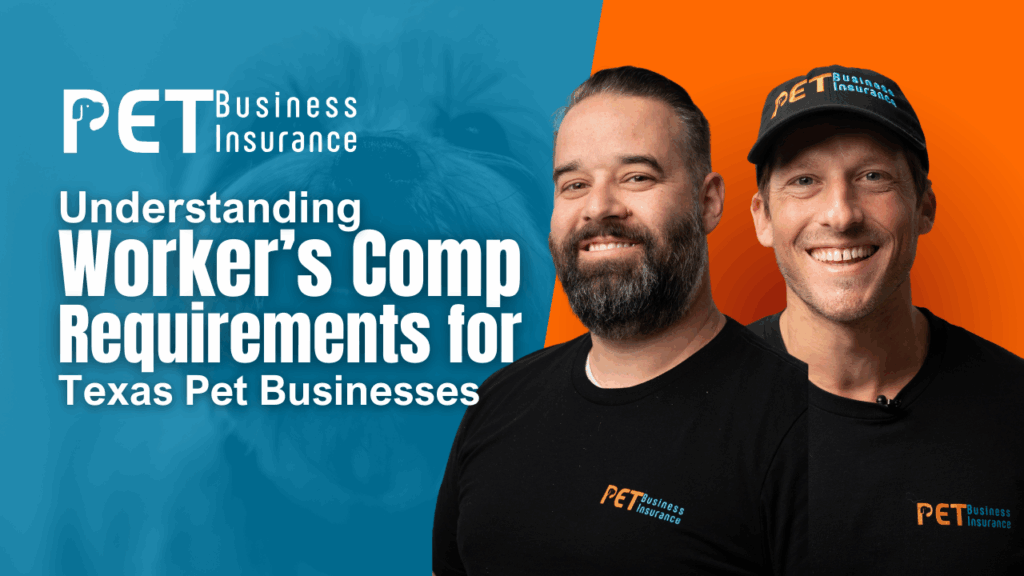
What happens if your groomer gets hurt on the job?
Would your business survive a $100,000 lawsuit? Would your employee know what to do if they got bitten or slipped on a wet floor?
If you own a pet business in Texas—whether it’s a boutique grooming shop, doggy daycare, or boarding facility—you’ve probably heard conflicting advice about workers’ comp. The truth? It’s complicated.
In this guide, we break down what Texas actually requires, how much coverage may cost you, and how to protect both your team and your bottom line.
Texas Workers’ Comp: Why It’s Different
Texas is the only state that doesn’t require private employers to carry workers’ compensation.
Instead, you’ve got three options:
- Subscribe to workers’ comp through an insurance carrier.
- Self-insure, if you meet strict financial qualifications.
- Go bare (non-subscriber)—meaning you opt out entirely.
Sounds flexible? It is—but flexibility brings risk. Let’s explore what each choice means for you.
What You Must Do—No Matter What
Regardless of your path, Texas law mandates a few key steps:
- Notify new hires of your workers’ comp status.
- Post required workplace notices based on your coverage.
- Non-subscribers must file an annual notice with the state.
- Update the Texas Department of Insurance and employees if your coverage changes.
Failing to comply can cost you up to $25,000 per day.
Pet Businesses Have Higher Risk Than You Think
You’re not running a construction site—but pet care carries real risks:
- Animal bites and scratches
- Muscle strain from lifting or restraining large pets
- Wet floors, sharp tools, and repetitive tasks
- Exposure to cleaning chemicals
If you’ve ever ended your shift with sore muscles or claw marks—you already understand the hazards.
What Workers’ Comp Actually Costs in Texas
Here’s a breakdown based on business size and payroll:
| Business Size | Annual Payroll | Estimated Premium | Effective Rate |
| Micro (1–3 employees) | $50K–$75K | $1,500–$3,000 | 3–4% of payroll |
| Small (4–10 employees) | $150K–$300K | $4,500–$12,000 | 3–4% of payroll |
| Medium (11–25 employees) | $350K–$750K | $10,500–$30,000 | 3–4% of payroll |
Strong safety programs can help lower your rate.
Non-Subscription: Cheaper Now, Expensive Later
Opting out may save you money upfront—but if someone gets hurt, here’s what you’re giving up:
- Legal protections: You lose defenses like contributory negligence.
- Damage caps: Courts can award unlimited damages.
- Peace of mind: A single bite could lead to a six-figure payout.
Real Example:
A Houston pet facility saved $8,500 by dropping coverage—then paid $175,000 in damages and $45,000 in legal fees after one incident.
Should You Subscribe or Not? Use This Framework
Use this decision-making guide:
- How likely is injury?
High-contact environments = higher risk. - What’s your worst-case scenario?
Think: dog bite, chemical burn, or fall. Can you cover $100K? - Do you have reserves?
If not, workers’ comp offers predictability over uncertainty.
For most Texas pet businesses, subscribing is the smart move.
If You Subscribe: Your Compliance Checklist
- Post Notice 6 & 8
- Notify all employees in writing
- Report injuries within 8 days
- File DWC Form-1 for any incident
- Maintain injury records for 5 years
- Bonus: Add a return-to-work program to reduce claim costs
If You Don’t Subscribe: Must-Do Actions
- Post Notice 5 in multiple languages
- File DWC Form-5 annually by April 30
- Report serious injuries with DWC Form-7
- Keep injury records for 5+ years
- Offer alternate benefits and secure liability insurance
- Bonus: Implement a return-to-work program
Skipping steps = major fines.
How to Cut Costs—With or Without Coverage
The best way to save money? Prevent claims. Start here:
Animal Handling Protocols
Train staff to assess temperament, use restraints, and respond to aggression.
Ergonomics
Install anti-fatigue mats, lifting tables, and teach proper body mechanics.
Chemical Safety
Use low-toxicity products, wear gloves, and ventilate well.
Slip Prevention
Grippy floors, posted signs, and proper footwear go a long way.
Real Result:
A Dallas pet chain reduced claims 62% and saved $7,500/year on premiums.
Claims Happen—Here’s How to Handle Them
- Act fast: Assign a response lead and notify your insurer.
- Offer light-duty roles: Keep injured staff involved with tasks like admin or customer service.
- Stay involved: Monitor treatments, check in regularly, and push for resolution.
So… Should You Get Workers’ Comp?
If you want:
- Legal protection
- Predictable costs
- Better employee morale
- Access to bigger contracts
Then yes, subscribe.
If you:
- Only have 1–2 employees
- Can handle legal risk
- Have strong liability protection
Then non-subscription might work—but tread carefully.
Conclusion: Clarity, Confidence, and Compliance
Now you know how Texas workers’ comp impacts your pet business.
Reminder: Injuries happen. Without coverage, the costs can be brutal.
We’re Here to Help:
At PetBusinessInsurance.com, we help shop owners protect their people, stay compliant, and save where it counts.
Next Step:
Get an instant insurance quote now.
